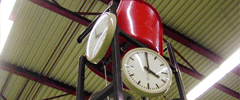Shipping card
With the already mentioned use of the Office program Excel by Andreas Nothaft on car cards, can also be made shipping labels.
Of the described freight lists we can insert these data in a basic list of shipping labels. Both the received goods and outgoing goods are defined in this data sheet. Thus we find trade routes "in the big world " for our customers. Only at very few meetings, is transportation routes for our customers at the event so large that transport on rails is justified. This also applies to the not shown volume between production and needs. Therefore, our customers use trading partners outside of the event. The 'big wide world' is represented by Fiddleyards.
To achieve greater clarity by meeting with several Fiddleyards over which wagons to be transported anywhere, and also to these establishments can be deployed more flexibly, a long time ago the "Fiddleyards-color" was introduced. So far, these color codes are made from a German viewpoint. With the internationalization of our unification, however, other definitions comes into play, such as on typical cargoes. (Tabel3).
New color is Orange. This is the future for general cargo tranship place; this tranship place is the recipient of all tranship cars. So all shipping labels for general cargo wagons keeps their validity for all future engagements.
Are all these things thought out and all fields are filled in the list, shipping labels created / printed. That Andreas Nothaft've made a tool in the form of this program, handwritten, often illegible, shipping labels thus belongs to the past. In addition there are a few good extra options in Andreas' program:
- Major cargoes: DLG must receive 200 tonnes of food. This cargo will not fit in one truckload. Therefore created 10 pieces shipping labels that provide more sheep reference "Sending consists of 10 wagons", printed in the "Remark"..
- Ilvogn: For perishable cargoes to be carried in Ilgodsnettet with general cargo. (Including fish, fruit, meat, etc.). On freight leaflet printed a red diagonal stripe.
- Flipnote: This refers to the vehicle's arrival would be extracted and then inverted so that the vehicle can start the next leg of the journey. This practice, unfortunately, the vehicle will always be a shuttle between the few establishments throughout the entire meeting. This was not even normal practice in cargo trailers at the track. This option should therefore be taken in preparation before a meeting.
Any station / operator should arrive at each meeting with appropriate wagons and 3 stacks preprinted shipping labels:
- Disposable freights: the goods that his clients receive. In a colored sender field can write a fictitious sender or that remain empty for possible use as "cargo ship"..
- Shipping freight: the goods that his customers send. Recipient field is always (!) a colored square where a fictitious customer, can be written.
- Empty waggon request: used empty wagons for shipment to his customers. Here must be the exact point, very important for the waggon. No indication of the sender.
Manufacture of cargo card
For the manufacture of cargo short, there are various options.
Andreas Nothaft has developed a car short program that is continuously improved, in MS-Excel form which is available for FREMO members. With this program cargo cards can also be produced. Meanwhile, also Georg Ziegler has devolopes a stand-alone solution. Available on the German side.





